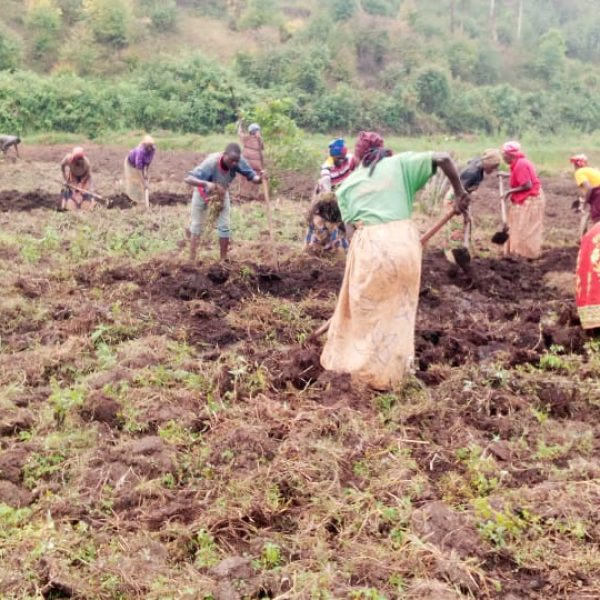Community Sustainable Agriculture
01.
Ecological Organic Agriculture (EOA)
The Ecological Organic Agriculture Initiative (EOA) is a national initiative that holds promise for increasing the productivity of Burundi’s smallholder farms, with significant impacts on the environment, biodiversity, and human health. The programme improves soil health, reduces pollution, and enhances biodiversity compared to conventional farming methods. We protect the territory where people once farmed, but after a long time nature has returned in all its diversity.
Seeing value in this outcome, the initiative has been implemented since 2018 first on a pilot basis in three districts (Rugombo, Murwi and Buganda in Cibitoke) and broadened to nine districts, namely in Bujumbura Rural in Mutimbuzi; Bubanza in Gihanga, Mpanda and Bubanza; Cibitoke in Mugina, Murwi, Mabayi, Buganda and Cankuzo in Giharo, with an overall goal of mainstreaming ecological agriculture nationwide through national agricultural production systems, plans and policies.

In order to support organic farmers and exporters, EdSF supported the establishment of organic agriculture plat-forms for knowledge dissemination through the inter-provincial campaigning and training workshops on organic standards and certification systems, organic production, marketing and extension.
What we do?
Research, Training and Extension
Information and Communication
Value Chain and Market Development
Networking and Partnership
Policy and Programme Development
Institutional Capacity Development

Approximately 2.2 billion people depend on groundwater for domestic use, with contamination of subsurface supplies thus posing a significant global health challenge. Furthermore, farming consumes about 70% of the Earth’s surface water and is the leading cause of water degradation. Except for water lost through evapotranspiration, agricultural water is recycled back to surface water and/or groundwater.
Water is a critical factor in agriculture, nutrition and broader human health issues.
It can serve as a carrier for both microbiological (e.g., bacteria, viruses) and chemical (e.g., heavy metals, pesticides) contaminants, potentially leading to foodborne illnesses and other health problems.
Through runoff of chemicals, waste and pathogens (e.g. manure spreading), inadequate land and water management practices facilitate the contamination of the environment and surrounding watersheds, negatively affecting users both downstream and at source.
EdSF provides management options for safely treating waste and protecting water quality and the safety of food that simultaneously offer additional benefits to farmers such as increased resource recovery of water, energy and nutrients from waste.
02.
Land and Water Quality for Food Safety
What we do?
Waste Treatment
Capacity building on treating wastewater from various sources, including livestock farms and highly contaminated slaughterhouse waste and effluent, to generate energy (biogas and/or briquettes) for the improved cooking stove, thus preserving the water quality of nearby watersheds for all users and preventing microbiological and chemical contamination of the environment.
Safe Irrigation Practices
Using innovative techniques, such as metagenomics for hydrological modeling, to identify hotspots within a hydrological unit. This approach targets available resources to specific and neighboring areas (hotspots), enabling them to proactively manage potential environmental sources of pathogens in agricultural products that could cause disease outbreaks.
Controlled irrigation methods
Using efficient irrigation methods like drip irrigation to minimize water waste and ensure that crops receive the right amount of water.
Soil health
Maintaining healthy soil through created water filtration systems to prevent the spread of contaminants.
Preventing Water Pollution
Sensitizing farmers on minimizing the use of pesticides and chemical fertilizers to help reduce water pollution from agricultural runoff.
Integrated manure management
Ensuring the properly managing animal manure to prevent it from polluting water sources. We practice integrated manure management to optimize handling of terrestrial animal manure from collection, through storage and treatment up to application (crops and aquaculture). Through this process it is possible to reduce the survival of pathogens and the persistence of antimicrobials and to prevent nutrient losses to a large extent under the site-specific circumstances.
Proper waste disposal
Preventing the disposal of hazardous chemicals, motor oil, and other pollutants into sewer systems to help protect water quality.
Composting
Composting food scraps and yard waste to reduce the amount of contaminants into the environment and negatively affect water quality.
Developing and implementing standards
• Developing and implementing national standards for improved organic manure treatment practices and manure treatment facilities to protect ecosystem services and preserve water quality for both up- and downstream users.
Network and partnerships building
Media and communication programs
• Collecting information and feedbacks pertaining to groundwater contamination risk draws from a multitude of sectors and disciplines (e.g. epidemiology, flood management, hydrogeology, food consumers, microbiology) for ecosystem resources management for the informed decision making.